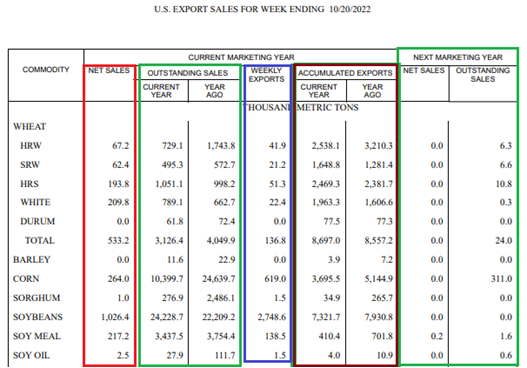
Last week I reported that the United States exports about 16% of its corn production, 48% of its soybeans, 52% of its wheat, 75% of its sorghum, and 95% of its cotton. Thus, it is important that buyers and sellers of these commodities fully understand how to accurately monitor exports.
Last week’s topic was the USDA Monday report called “Export Inspections,” the weekly summary of quantity of food and fiber commodities grown in the U.S. that had been loaded on a ship, train, or barge to be delivered to a foreign country during the reporting week ending the previous Thursday. Once a load has been inspected by USDA, it is ready to depart, but inspection does not mean that load did leave the USA that week. Sure, most of the loads leave the same week as inspected, but not necessarily.
Somebody must buy a commodity before anything else can happen. Every Thursday, the USDA issues an Export Sales Report so all market participants know how much of each commodity was purchased the previous week ending the previous Thursday, same week covered by Monday’s Export Inspections.
The first chart below is the USDA summary for export sales for the week ending Thursday, October 20, 2022. The red box on the left is the number of metric tons (mts = 2204 pounds) of each commodity contracted (sold) for export during the current marketing year for the reporting week.
These are the numbers that will move the market for a few minutes if they are substantially different than what was expected.
The green box on the left is the mts of the various commodities that have been booked for export this marketing year, but have not been shipped. The two columns are labeled “Current Year” and “Year Ago” so one can easily see the difference. This week, the outstanding corn sales pace is less than half of a year ago. You can also see the outstanding soybean sales are 2,000 mts above last year’s pace for this date.
If you grow hard red spring wheat, you like what you see in the outstanding sales, but if you grow hard red winter wheat, you are not liking what you see.
The blue rectangle in the middle reports the amount of each commodity that actually departed the country for the week. This total will be close to the Export Inspections number on Monday, but it will be different. A ship load inspected on Thursday afternoon is included in weekly Export Inspection, but if the ship left port after midnight Thursday, it would not be included in weekly exports.
The dirty red rectangle is the accumulated export tonnage that has actually departed the country for the current marketing year to date and the previous marketing year to date.
The far-right green box are the sales for the week for the next marketing year and the year to date. This information becomes much more important as end of the old crop year nears.

This year’s unshipped sales and this year’s actual shipments compared to a year ago are important numbers for cash market sellers and buyers of these commodities. But the most important export numbers are not on this report.
The USDA issues a monthly Supply and Demand Report (S&D), which includes the expected export total for three marketing years. If the export sales pace this year is running above a year ago and the USDA projects exports will be the same or less than a year ago, one can expect the USDA will raise the exports and decrease the carryout in the coming months, which will be supportive for the price.
If you know what percentage of change the USDA projects for the current year compared to the previous year and what the percentage of change actually is for the year-to-date, then you have a clear picture of what changes the USDA is likely to make in the coming months.
To keep our clients informed of how exports are doing compared to the USDA’s projection for the year, we prepare the following chart every week, which combines unshipped sales and actual exports to get total sales to date:
With just a glance, you can see why everyone is bad-mouthing corn exports. Year-to-date corn sales are down 52.7% with USDA projecting a decline of just 8.1%. Gosh, do you think there is chance USDA will reduce corn exports on the Nov. 9 S&D? How about sorghum? Soyoil? With a little inspection, you can readily see the two commodities that will not have a reduction of exports on the November S&D.
One needs to consider how deep into the marketing year we are and unusual events that impact exports. This year, we have low water on the rivers. Last year we had Hurricane Ida hit the Mississippi River ports in late August that kept most of the ships from being loaded until the middle of October.
You can track weekly USDA Export Inspections and sales here and here.
This is part two in a series. Read part one: Weekly export data offers long-term price clues
Wright is an Ohio-based grain marketing consultant. Contact him at (937) 605-1061 or [email protected]. Read more insights at www.wrightonthemarket.com.
No one associated with Wright on the Market is a cash grain broker nor a futures market broker. All information presented is researched and believed to be true and correct, but nothing is 100% in this business.
The opinions of the author are not necessarily those of Farm Futures or Farm Progress.
About the Author(s)
You May Also Like






